Located directly west of Tokyo in the Chubu region of Central Japan, Yamanashi has much to offer those who visit.
While many tourists bypass it by heading straight to Nagano or opting for the Shizuoka Mt Fuji view, if you make the trip, I guarantee you will be satisfied with what Yamanashi offers.
Without the crowds that other popular destinations are troubled by, it is an ideal location for a quick trip from the big city for fresh air, beautiful mountains, hot springs, and delicious Yamanashi food!

Table of Contents
Fruit-Picking (果物狩り,くだものがり)
Known as Japan’s Fruit Kingdom, Yamanashi offers various fruit-picking experiences (kudamono-gari) from spring to fall. Fruit is even embedded in its name– yama (山・ mountain), nashi (梨・pear)– making Yamanashi a perfect place to enjoy sweet, fresh fruit right from the tree. You can experience picking pears, cherries, grapes, peaches, strawberries, and blueberries!
Surrounded by mountains, including the Southern Alps and Mt Fuji which help block the area from catastrophic storms, Yamanashi’s basin has a large amount of flat land and healthy soil, ideal for growing fruit. Yamanashi also boasts the longest day of sunlight recorded in Japan, making the days long and warm, and the nights cool, which helps sweeten the fruit.
One of the most popular fruit farms is Nakagomi Orchard (中込農園, なかごみ・のうえん) because of its wide variety of fruit experiences running from June to November, with staff able to communicate in English and Chinese.
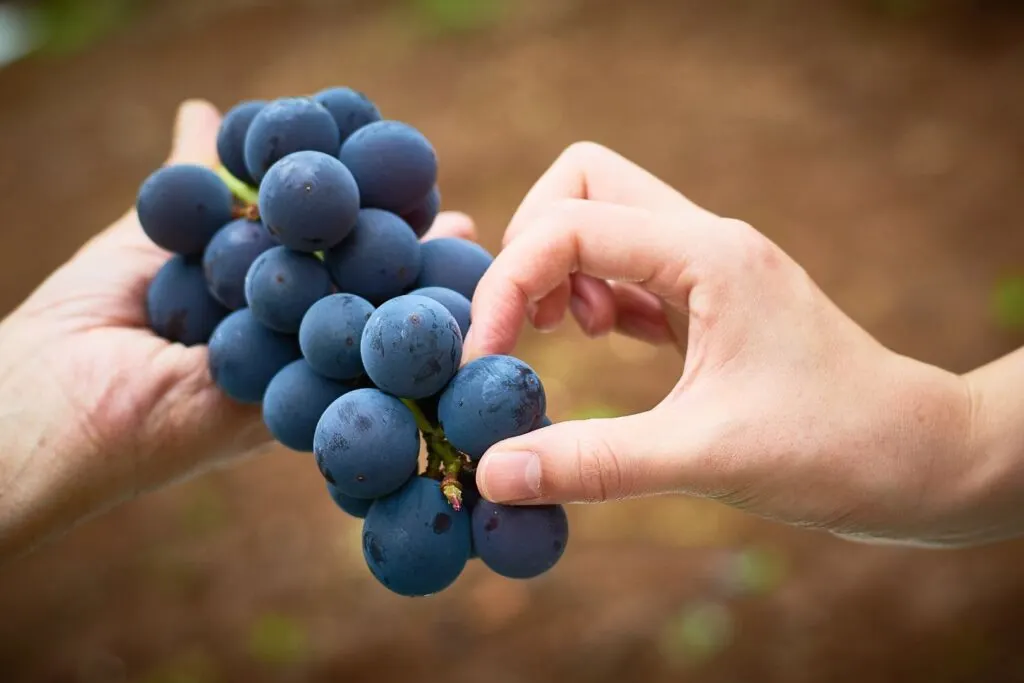
Hoto (ほうとう)
If you visit during the winter, you can’t miss the hearty and filling dish, Hoto (hōtō). Noodles are a main staple in Japan, from ramen to soba, but this noodle dish has several characteristics that make it unique. Like udon, the noodles are made from wheat flour, although Hoto noodles contain eggs, making them richer and more filling.
The noodles are wider and flatter than udon noodles and are cooked until they are soft and chewy. They are then cooked in a miso or soy sauce broth with local vegetables of the region, with pumpkin being the favorite.
This dish is the pride of Yamanashi, and locals have been eating it for centuries. Cooked in a big communal pot over an open flame and similar to a Japanese hot pot, it makes a perfect dish to warm up over a social gathering with family and friends.
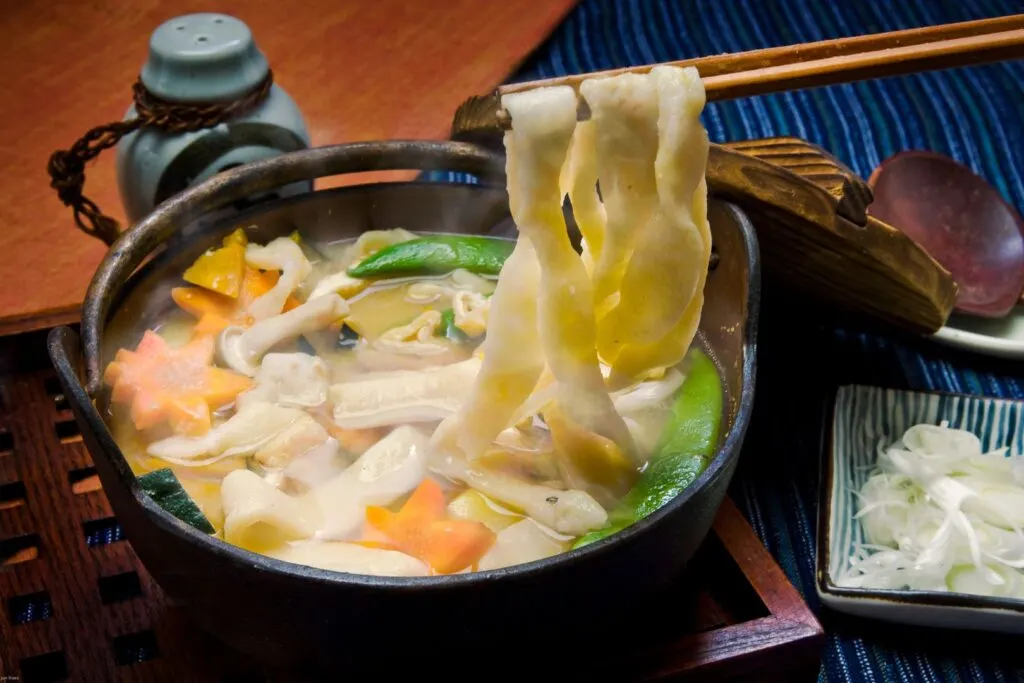
Koshu Wine Beef (甲州ワイン牛, こうしゅうワインビーフ)
For those who have long loved Japan’s well-known famous beef varieties–Kobe beef, Matsusaka beef, and other Wagyu beef–you can’t miss Koshu (Kōshū) Wine Beef. Its rich and meaty umami flavor stands out from its counterparts’ more subtle flavors.
The Japanese Black cattle are fed on a diet of local grains, hay, and some of Japan’s purest mineral spring water. The climate, terrain, and diet contribute to this beef’s unique flavor.
One downfall of its rarity yet highly sought reputation is that it is usually only found in expensive restaurants. It will definitely dip into your wallet, but experiencing one of the finest types of beef worldwide is undoubtedly worth it.
Minobu Yuba (身延湯葉, みのぶゆば)
If you find yourselves in Yamanashi on the south side of Mt Fuji, jump over to Minobu and try the Minobu Yuba. This traditional Buddhist vegetarian dish is said to date back over 700 years. Yuba is created by simmering soy milk until a thin layer forms on the surface and is then carefully removed with bamboo sticks.
It is often served in soups, stews, and grilled or boiled with accompanying dipping sauces. The sweet, nutty flavor and unique texture may not match everyone’s palette, but rich in protein and fiber, it is undeniably a healthy option for all.
Kofu’s Boiled Chicken Offal (甲府鳥もつ煮, こうふとりもつに)
For those looking to eat a bit more adventurously, Kofu (Kōfu) has just the delicacy for you. Offal is the innards of an animal, so if you don’t find this awful, then you can enjoy chicken liver (レバー), gizzards (砂肝, すなぎも), heart (ハツ), intestines (小腸, しょうちょう), and the immature eggs of hens (sometimes referred to as ‘kinkan’ or kumquats in Japanese) — soaked in a sweet and spicy soy sauce.
Said to have been first created in Kofu at a soba restaurant in 1950, you can now easily find this dish alongside the other offerings at soba restaurants or izakayas throughout Kofu city.
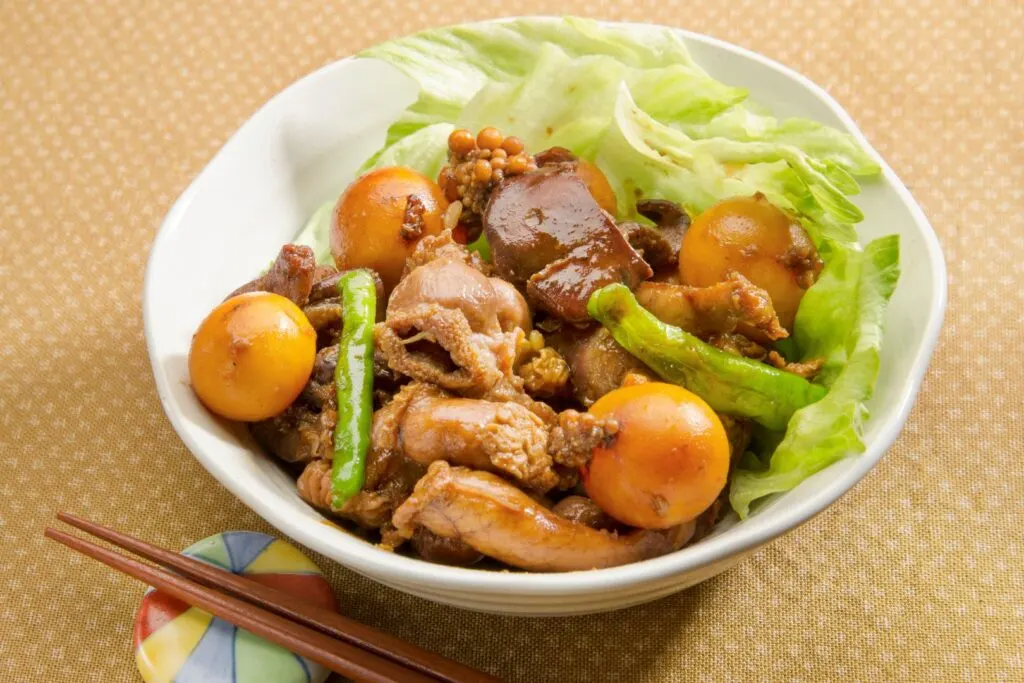
Wild Game (ジビエ)
For those who have a bit more “wild” in them, head up to the mountains close to Nagano to try gibier. There you will find a restaurant, Kobuchizawa Yatsugatake Kozō (小淵沢 八ヶ岳小僧, やつがたけこぞう), featuring ayu sweetfish (鮎, あゆ), deer (鹿, しか・シカ), wild boar (猪, いのしし・イノシシ), badger (穴熊, あなぐま・アナグマ), and common raccoon (アライグマ).
The menu has a variety of set dishes that prepare the meat as tempura, hot pot, grilled meat, or steaks. It’s not cheap, though, so for those looking for something more casual, try Yatsugatake Vegibier, a hamburger restaurant right around the corner at the Hoshino Resort. If you time it right and beat the crowds, you can enjoy deer or wild boar burgers.
Shingen Mochi (信玄餅, しんげんもち)
While in Yamanashi, you can’t miss Shingen Mochi, a sweet treat available in souvenir shops all over Yamanashi. Its texture is similar to other sticky rice cakes, but the secret is in the sauce for this treat.
It’s made with water, agar– a gelatinous substance extracted from seaweed– and a brown sugar syrup that you pour over the mochi ball. As the syrup mixes with the kinako powder— a roasted soybean flour— it forms a jelly-like layer.
Use the kashiwa– a little wooden stick— to mix it all together and enjoy the chewy, sweet, and nutty-flavored treat! You’ll want to be seated for this, though, as it’s messy! Not only is this treat a favorite for foreigners, but it’s also a standard souvenir for the Japanese.
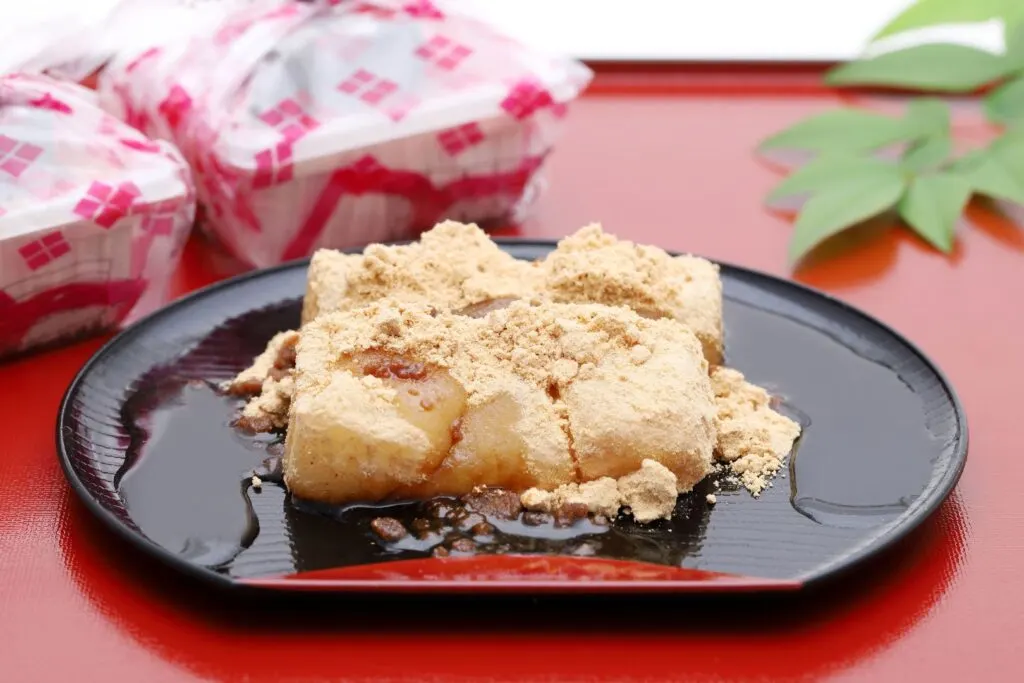
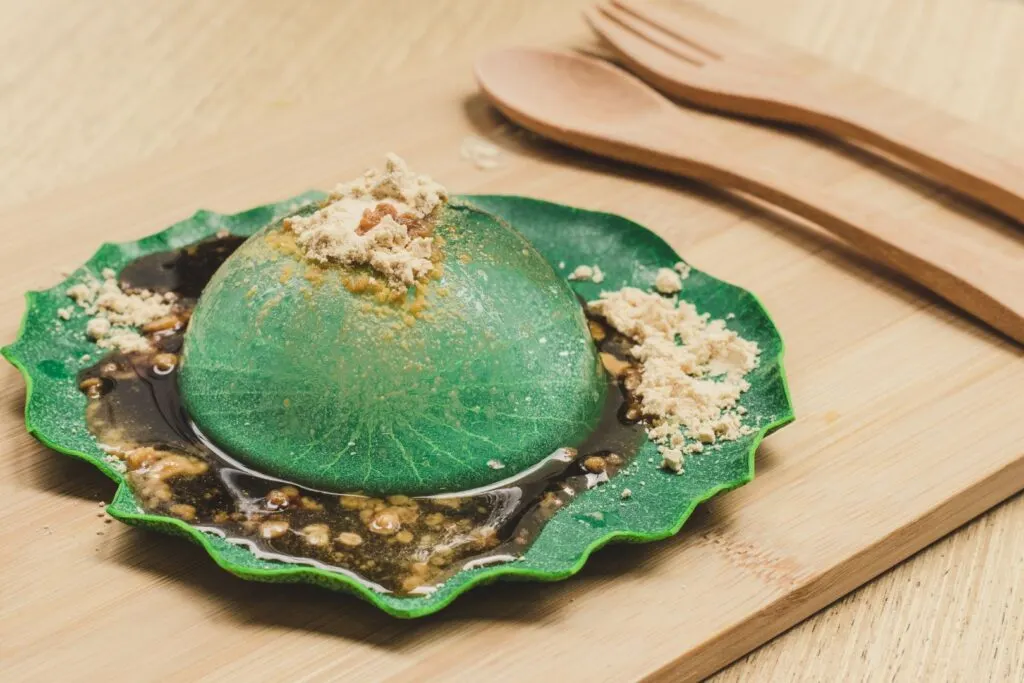
Natural Spring Mineral Water (天然のミネラルウォーター, てんねんのミネラルウォーター)
Last but not least, one of the main reasons all the above dishes are so delicious is the abundance of natural spring water in Yamanashi. Rain and snow in the mountains moisten the soil, creating several unique and impressive bodies of water around the prefecture, including the Fuji Five Lakes to numerous waterfalls, lakes, and rivers.
The process of natural spring mineral water can be seen in the ice caves of Narusawa (鳴沢氷穴, なるさわひょうけつ ), where the ice has formed from water dripping down from the roofs of the caves or in the greenish-blue spring water ponds of Oshino Hakkai (忍野八海, おしのはっかい), replenished by the snowmelt of Mt Fuji [English Info].
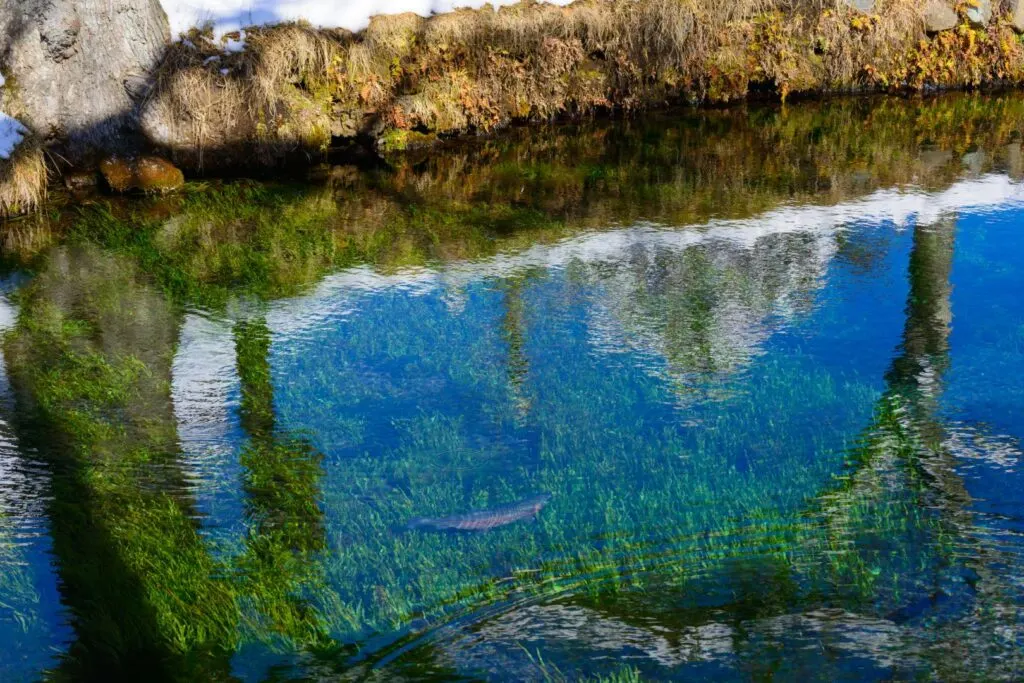
One of the most famous bottled water makers produces its product in Yamanashi, Natural Mineral Water from the Minami Alps (南アルプスの天然水, みなみアルプスのてんねんすい) as well. However, if you’d like to skip the plastic bottle, we recommend stopping at one of the unique places around Yamanashi where you can draw the spring water yourself.
Such places include the Michi no Eki Fujiyoshida (道の駅富士吉田, みちのえきふじよしだ・富士山の水汲み場、ふじさんのみずくみば), a roadside station in Fujiyoshida with water pumping stations, Sanbuichiyūsui (三分一湧水, さんぶいちゆうすい) [English Info], and Michi no Eki Hakushū (道の駅白州, みちのえきはくしゅう) [English Info].
What is your favorite Yamanashi food? What Yamanashi food would you most like to try?
Pin me for later
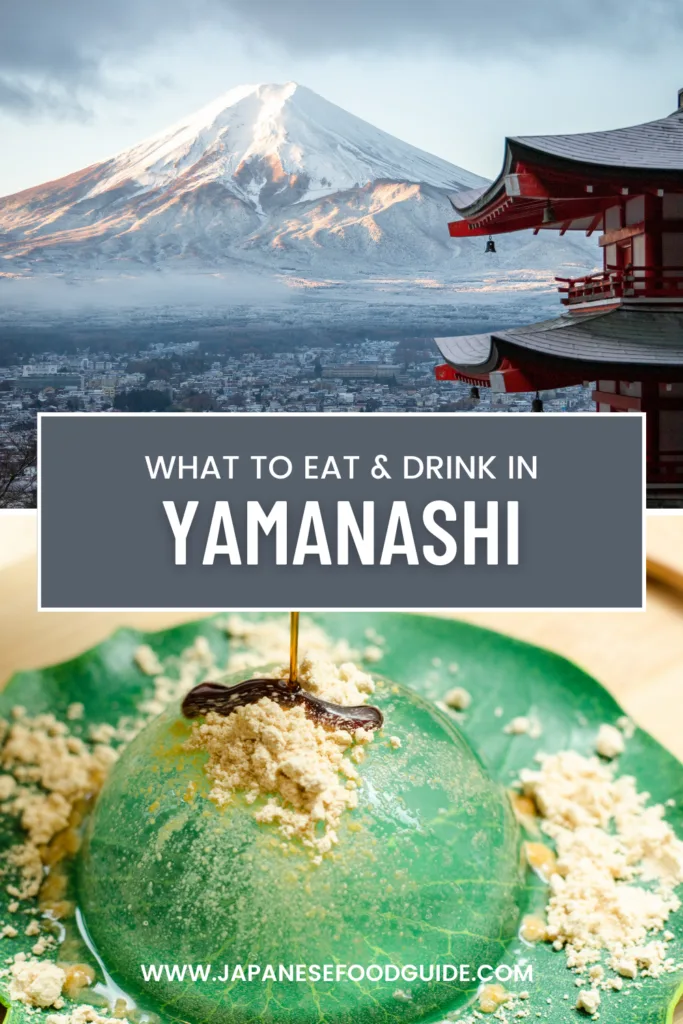
Devon Furuta grew up in Colorado, a place that boasts more than 300 sunny days a year. It’s no wonder she now finds herself in the sunniest place in Japan, Yamanashi.
With that inherited sunny disposition, she works to brighten the days of those around her through teaching, writing, and translation. You’ll also often find her messing around with musical instruments, reading Japanese novels, or pruning the many trees in her garden.

Jessie
Saturday 13th of May 2023
Thank you for sharing plastic-free water sources! All the food sounds delicious (except for the egg sacs - lol).